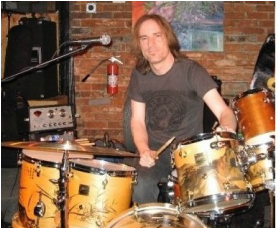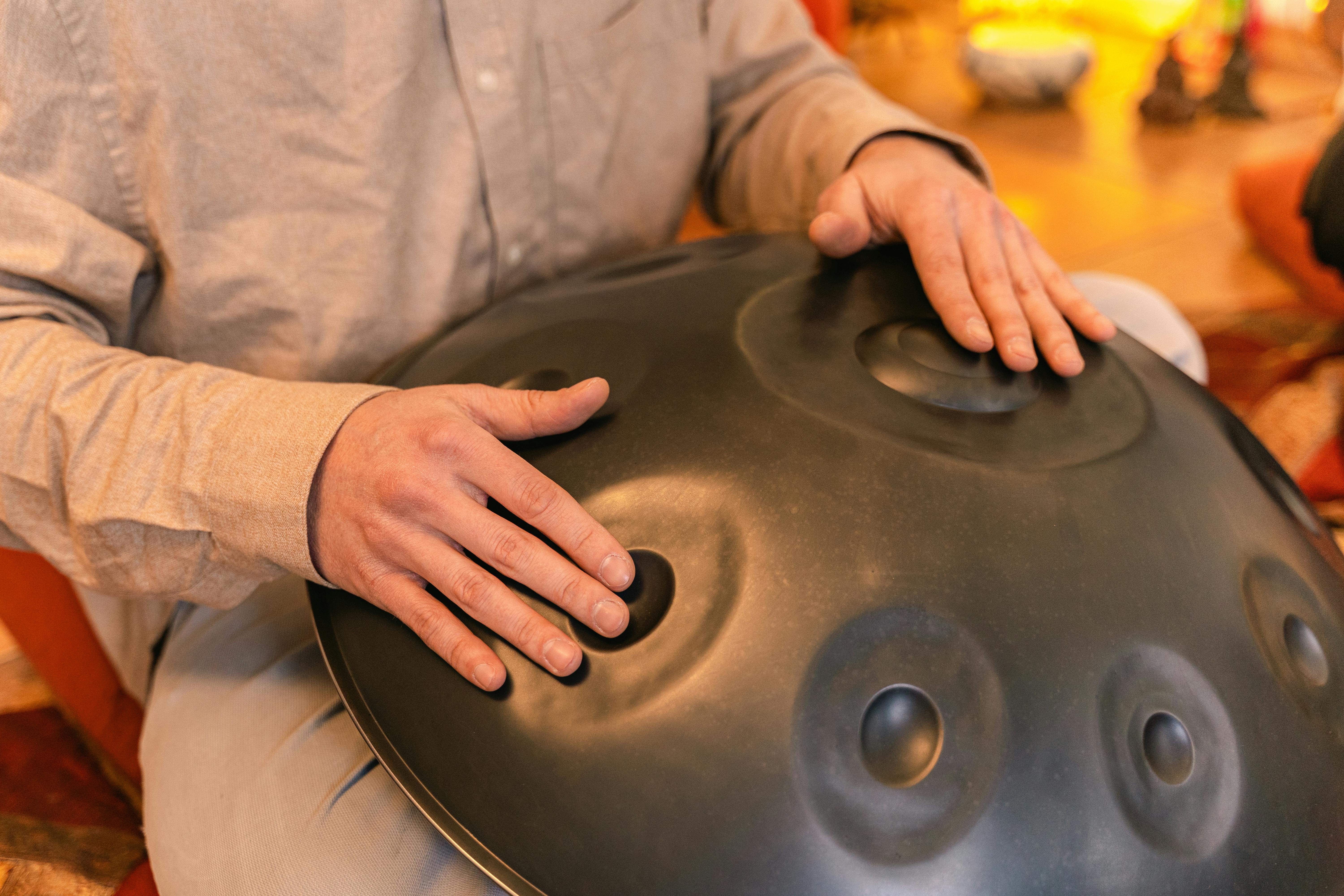When it comes to versatility in the percussion world, Chris Wabich is no stranger. His background includes advanced degrees in percussion, compositions, arranging, playing, building and tuning, jazz drumming both live and recorded, and performances and recordings with noted artists that include Sting, Jimmy Johnson, Bad Haggis, Robert Greenidge and Len “Boogsie” Sharpe. With his zany style, strong opinions, and ambitious drive, Wabich has made a name for himself all over the world both as a drummer and Panist.
PM sat down with Chris to discuss his roots, musical direction and opinions on the current and future state of Pan.
What inspired you to be a musician/drummer?
Music chose me first. From my first memory, I was always attached to my mom’s box of 45s and a record player.
What’s your background?
I’ve played drums since I was seven, classical percussion since age nine and Pans since age 18. I have three degrees in music including a MM in classical percussion. I’ve been in LA for almost 25 years now and made a living primarily performing and recording music. I’ve recorded a few hundred CD projects including 30 as producer. I play a bunch of jazz gigs around the LA area and am currently music director for a few projects such as:
- “Thelonious Monkey,” a jazz quintet with strings playing all my compositions and arrangements (also including a few great charts by Jenny Ing). We play around LA monthly and the band is getting better and better.
- “Margo Rey,” an artist on Sony/Electra that I tour with. I’ve co-written and collaborated on her six billboard-charting releases including songs with John Oates (Hall and Oates). We tour constantly and it’s a very pro situation in which I’m proud to be collaborating.
- “BOTH” is a Beatles show in LA that I music direct every year. The cast has so many great vocalists including Maiya Sykes (the voice) Laura Jane Jones (Marc Anthony)
- Jason Paige (Blood Sweat and Tears) Ty Taylor (vintage trouble) really fun to do gospel versions of Beatles tunes.
- “BICHNG PRODUCTIONS” – a production team with my better half, Jenny Ing. She has a real handle on writing catchy tunes. It gives me a chance to exercise production chops literally doing everything else (play guitars, drums, 2nd keyboards, record, mix, etc.) It’s great to keep these skills together as part of the LA studio scene. Great tones!
How did you get introduced to Pan? What inspired you to pursue making and playing Pan?
My first exposure was at Disney World, Fla. in the late 70s. The band there was playing “old style” pans. Later on I listened to Jaco’s band with Othello and got reacquainted with the idea of Pans in college in 1987 at ASU (Appalachian State – Scott Meister) . I came to them by searching for a legato voice. I was constantly dissatisfied with intonation and timbre, which led me to eventually build my own drums.
What is your preferred Steelpan instrument to perform on? Why?
It depends more on the situation and if I am playing with a band or not. Obviously Doubles are the most versatile and THE MAN’s instrument. I think less and play ideas better on Lead, but Lead is a bangy, mid-range voice. It’s really fun to play gigs on Bass Pans but that rarely happens.
Overall I stick to Lead just for time efficiency since I’m running all over the place. I have an oversized Lead I’ll eventually finish with the octaves positioned sideways instead, resulting in a Doubles sound. It’s been staring at me to finish for a few years. Need. More. Time. Thanks!
As a professional jazz drummer and composer/arranger, what do you hope to accomplish by adding the Steelpan to the instrumentation as you have for live shows and recordings?
Easy. I’d like to put Pans in the spotlight when they need to be and not use them when they aren’t the right color. Pannists tend to overuse them because it’s their primary instrument. I strive to make the most musical choice for orchestration.
Pans are a plate reverb sounding instrument… get this idea. Each note contains harmonics that define its character as not just a fundamental thud. Without these harmonics, Pans would have the 1950’s “clunk clunk” sound. In addition, the “skirt” functions as additional reverb, adding note duration.
To me, Pans are best used as an accent instrument in acoustic music. They are a sensational color and easily recognizable, great for a whistling voice on top or bubbly chording in the mid range. Bass Pans are great for replacing the upright bass with a volume that can be heard over drumset.
In mixed instrument ensembles, Pans can wear out their welcome by playing the melody and the solo AND comping AND playing a montuno behind the drum solo, etc. One modern idea/rule is to incorporate dead strokes for non-important sections (such as comping) and have the non-pan instrument take the first solo to better separate the solo section from the pan melody. Lay out a LOT. This will help with small ensemble orchestration.
Who are your biggest musical influences, both Pan players and other instruments?
Too big of a list! Pan players gravitate towards one school or the other (Ray, Professor, Boogsie, Robbert G., Liam, Jit, Andy, etc.). I find Boogsie to have tremendous creative soloing and cool comping ideas. Robert Greenidge has one of the best tones/touch I know of, really special. All the Panists listed above have something great in their playing, worth checking out if you are serious about Pan. You have to take a little from everyone.
For other instruments.. wow.. let’s limit to just a few people for sake of space!
Ahmad Jamal – perfect example of how to orchestrate live trio music to sound like a large ensemble. Really sparse comping, right in the pocket. Just amazing orchestration.
Frank Sinatra/Ella Fitzgerald – phrasing! You can argue endlessly about who has the “best” version of standards but you can’t deny Frank and Ella’s versions are often at the top.
Ellington – orchestration – environmental sounds to frame a song’s mood.
Wayne Shorter – he’s Wayne Shorter!… go check it out! Composer of the best short form standards ever.
Ivo Paposov – a crazy leader of crazy music!
For drum set… I like drummers that are aware of the history but also have their own voice (no copycats!!!!) That being said, enter: Papa Joe, Max, Tony, ELVIN, Al Foster, Salif Ali Sasko, Vinnie Colaiuta, Mark Guilana. I’ll stop there because its starting to sound like one of THOSE top 10 lists where everyone responds with their own top 10 and it’s a blood bath. Just go listen!!
What are your favorite performance moments playing Steelpan and why?
I’m not too concerned with this. I always play my best no matter if people are listening or not. It helps to lift spirits and move forward. The time spent behind the instrument is the same no matter what. I try to make the most of it. Ideally I enjoy every moment rather than worrying about applause. An example is the time PANic All-Stars chose to keep rehearsal even though it was three hours after the 9-11 incident. Great statement on the human condition and being uplifting.
I have fun on a lot of recording sessions. One memorable one was the soundtrack for Sting. There was a time pressure to get the parts done asap because others failed before and I was recommended to fix everything. I remember a really hairy Doubles part in 7/4 that didn’t make sense and somehow I zenned it out – with feeling – on the first pass. Muting notes like a vibes part. There were 9 tracks in 4 hours, including overdubs on percussion, drum kit and Pans. Pheew.
Who is your favorite composer/arranger for Steelpan? Who are some rising stars that people should keep an eye on? Why?
Every influence I mentioned has valid ideas and great contributions that I like. I am a continuation of that history because of the sum total of it, not for any one favorite track. There are rising star Pan players. Entirely different topic! Of the batch I consider Victor Provost the most prominent. Super knowledgeable cat!
For the rising star composers (20-30 year-old, non-Caribbean based), I haven’t heard a thought-out, complete voice for steel orchestra, especially compared to the masters such as Ray Holman, Boogsie, etc. Let’s backtrack for a moment.
For the mid career generation, there are a lot of very qualified arrangers, way too many to mention. Most American and European steel bands in the 80s-90s had no sheet music to purchase. The leaders had to write all the charts.
A great example is found where I teach in Tucson. Dave and Tina Walton have an enormous collection of arrangements they’ve done. Kris Dodge has consistently written new, original music every year since I’ve known him. Jeannine Remy was in the area arranging over 25 years ago. People like this aren’t up and coming, they are the original first wave of the American steel band movement.
Skip to now and young composers are writing non-Caribbean music. I hear lots of interesting reactionary type ideas but no complete new ideology for full steel orchestra, nothing that 100% works from beginning to end as a musical statement first. There are, however, a few sensational moments found in these special effect/architectural pieces. These ideas need to be refined.
That being said, what’s going awry with current ensemble compositions?
One issue is a lot of Lead Pan players are composing but haven’t learned the proper practice of the lower pans. They write lots of fast party tricks that only work on lead but fail on Doubles, Guitars and Bass. Their background parts are simple, pattern-based riffs over very few chords. This is predictable version 1.0.
Composers are falling into the cliché of playing Pans with various “other” mallets and running a bunch of arpeggios and patterns. There is zero melody/harmony/rhythmic development in this approach. Its not really a composition without those elements… its …arpeggios… it won’t survive. Do this on trumpet and people get annoyed!!
Remedies? Ideas how to fix this?
Composers need to find their own specific effects and use them in a musical way, not ideas that are new for new’s sake. For example, pitches can be bent upward by as much as a whole tone by pressing the octave area in just the right spot. Pitches can be detuned with magnets. Do this twice in a piece and its part of the musical statement, a success. Do it as a three-minute, nonstop pattern and it’s a disposable party trick.
There needs to be melody followed by development of that melody. There need to be performable, melodic support parts. There needs to be less “pattern” music and more space.
I’m not being discouraging, quite the opposite. I’d love the literature to be rich with non-Caribbean pieces the public is dying to hear a second and third and hundredth time (think Brahms). For this to happen, consider the future of Pan. Great MUSIC survives the test of time. People will always want to play “Pan Woman” because it’s a great composition. If you haven’t heard it, why are you wasting time? Go check it!
Of the wide collections of your albums (LOUD! Soundscape In Steel, Sheltering Ska, etc.) with Steelpan as the featured instrument, which is your favorite? Why? Which would you consider most successful?
Other pannists consider LOUD to be one of my best records. It made a statement about a progressive style with a small band. LOUD is an example of very functional drum kit playing for small band (no percussionist). I still like “Agra” as being a Bass Pan feature. I also love that it was recorded live on tour with only four mics for the whole band. Tremendous sound quality considering.
For the solo record series on iTunes, “Sheltering Ska” was decent because it took the subject matter of Sting and the Police extremely off script. It’s like a cartoon where the main character bails on the writers and leaves town. You follow him on that journey instead of the one you expected. “Message In a Bottle” has a ton of hidden gems, one of them being the chords where the lyrics fall. “I hope someone gets my” has increasing optimistic chords. Then ends with the least optimistic option when you realize you are trapped there (quintal harmony)… but then its OK you’re trapped on an island (re-intro) because it’s a fun place to be trapped in anyway (Maj. 7 type of progression). It’s telling its own story against the context of that well-worn tale.
The biggest Police enthusiast I know, one of the top six collectors in the world, said he liked my “Roxanne” much better than the original. I transposed the melody to a different interval relation to create a much more desperate sounding version. The mood is better suited as a Lead/Doubles duet. A conversation between two people (as the lyrics are) I’ll start orchestrating these for full band next year. FUN!
For the original Pan library (2008 and back), I chose to stay on destructible recording medium (ADATs). I had pro tools, but preferred the idea of recording with the old mentality. Either keep the part or dump it. No “fix it in the mix”. To record this way you need a clear vision of the song structure and vibe before tracking. I preferred having minimal effects and eq on the mics. The drumkit was four mics, Pans were all earthworks mics in a stereo configuration. I realize as a producer that people expect a slick, refined product, but I preferred to keep those projects as jazzy report cards with spot-on tuning of the instruments.
Probably the most successful CD is the live jazz trio record with Boogsie and me on drum kit. Boogsie used a set of Doubles I made and left everyone speechless. Reminds me…I need to remix this and get it in digital distribution!!! Please bug me to finish this in 2015!
As faculty at the University of Arizona, Tucson, what is your goal in educating both students and the public on the instrument? What is your approach to Pan education and what is the most important message you plan on passing on to students and the public about the instrument?
Luckily in Arizona there are the most Pan bands per capita in the USA. UA was one of the earlier universities in the USA to have pans. As a result, I don’t need to explain what the instruments are, but rather my take on what we are doing with them.
There hasn’t been enough time to pass on and codify all the philosophy I have about the instrument. This is not specific to UA, but mainly a detail of teaching Americans who don’t have a world music ear. UA has been going well and more philosophical ideas will be explored in spring. I’m really looking forward to codifying more of the ideas I’ve had for big band.
For now the approach has been to get everyone playing a lot. I find things work themselves out better that way for confidence rather than stopping every four bars teaching the history of strumming when students haven’t heard it in context their whole life. Best to point out the rhythms and play along. Get the music in everyone’s bones. Listening and playing, that’s the best way.
What is the most detrimental thing keeping the instrument from rising above its long-established novelty status? Given the success it has had being integrated in the cultures of many other countries like Finland, Sweden, England and Japan, what can U.S. players, builders and educators do to help remove the “island music” stigma it has been unfairly saddled with?
This is best answered by writing lasting, real music that changes the landscape worldwide. If you want to remove the Caribbean element from Pan you have to create a body of original, quality work that does that. There are worse things in life than Pans being associated with Caribbean culture. If you think about it, it’s a good introduction to forms of ethnic drumming and jazz music.
What are your goals with the instrument in the foreseeable future?
Write more! Stay away from the complainers! Stay out of construction/ tuning debates! (ew!) I’m in a process of combining all the extended techniques that are in my head in a way that is most musical.

Chris Wabich performing at the Blue Whale, Los Angeles with his group, “Thelonius Monkey”.








